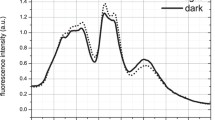Abstract
-
1.
A hypothesis based on the Hill-Bendall-model of photosynthetic electron transport is proposed to explain positive and negative photo-phobotaxis inPhormidium uncinatum. In the non-cyclic electron chain a pool is located into which photosystem II (e. g. by absorption by C-phycoerythrin, 561 nm) feeds electrons while photosystem I (e.g. 723 nm) drains electrons out of it.
-
2.
Interruption of the electron flow into the pool causes a sudden decrease of the pool size and thus a positive phobic response. This happens e.g. when an organism leaves a trap which is illuminated by a wavelength absorbed by photosystem II pigments (e. g. 561 nm).
-
3.
A negative reaction takes place when electrons are suddenly drained out of the pool; again the pool size decreases. This is the case when an organism enters a light trap illuminated by photosystem I light (723 nm).
-
4.
The net flow of electrons into or out of the pool—and thus the reaction sense—can be manipulated by the relative excitation of the two photosystems or by blocking the electron influx by DCMU.
Similar content being viewed by others
References
Bouges-Bocquet, B.: Electron transfer between the two photosystems in spinach chloroplasis. Biochim. biophys. Acta (Amst.)314, 250–256 (1973)
Drews, G.: Die phototaktischen Reaktionen einiger Cyanophyceen. Ber. dtsch. bot. Ges.70, 259–262 (1957)
Emerson, R., Rabinowitch, E.: Red drop and role of auxiliary pigments in photosynthesis. Plant Physiol.35, 477–485 (1960)
Engelmann, Th. W.: Über die Licht- und Farbenperzeption niederster Organismen. Pflügers Arch. ges. Physiol.29, 387–400 (1882)
Häder, D.-P.: Untersuchungen zur Photo-phobotaxis beiPhormidium uncinatum. Thesis, Marburg 1973
Häder, D.-P., Nultsch, W.: Negative photo-phobotactic reactions inPhormidium uncinatum. Photochem. Photobiol.18, 311–317 (1973)
Halldal, P.: The photosynthetic apparatus of microalgae and its adaptation to environmental factors. In: P. Halldal, Ed.; Photobiology of microorganisms. London-New York-Sydney-Toronto: Wiley 1970
Haupt, W.: Die Phototaxis der Algen, Handbuch der Pflanzenphysiologie, Bd. 17/1, S. 318–370. Berlin-Göttingen-Heidelberg: Springer 1959
Hill, R., Bendall, F., Function of two cytochrome components in chloroplasts: A working hypothesis. Nature (Lond.)186, 136–137 (1960)
Hirose, H., Kumano, S., Madono, K.: Spectroscopic studies on phycoerythrins from cyanophycean and rhodophycean algae with special reference to their phylogenetical relations. Bot. Mag. (Tokyo)82, 197–203 (1969)
Joliot, P., Joliot, A., Kok, B.: Analysis of the interaction between the two photosystems in isolated chloroplasts. Biochim. biophys. Acta (Amst.)153, 635–652 (1968)
Links, J.: A hypothesis for the mechanism of phobochemotaxis. Thesis, Leiden 1955
Nultsch, W.: Der Einfluß des Lichtes auf die Bewegung der Cyanophyceen. III. Mitt.: Photophobotaxis vonPhormidium uncinatum. Planta (Berl.)58, 647–663 (1962a)
Nultsch, W.: Phototaktisches Aktionsspektrum von Cyanophyceen. Ber. dtsch. Bot. Ges.75, 443–453 (1962b)
Nultsch, W.: Light reaction systems in cyanophyceae. Photochem. Photobiol.4, 613–619 (1965)
Nultsch, W.: Untersuchungen über den Einfluß von Entkopplern auf die Bewegungsaktivität und das phototaktische Reaktionsverhalten blaugrüner Algen. Z. Pflanzenphysiol.56, 1–11 (1967)
Nultsch, W.: Einfluß von Redoxsystemen auf die Bewegungsaktivität und das phototaktische Reaktionsverhalten vonPhormidium uncinatum. Arch. Mikrobiol.63, 295–320 (1968)
Nultsch, W.: Photomotion of microorganisms and its interaction with photosynthesis. In: P. Halldal, Ed., Photobiology of microorganisms. London-New York-Sydney-Toronto: Wiley 1970
Nultsch, W., Häder, D.-P.: Bestimmung der photo-phobotaktischen Unterschiedsschwelle beiPhormidium uncinatum. Ber. dtsch. Bot. Ges.83, 185–192 (1970)
Nultsch, W., Richter, G.: Aktionsspektren des photosynthetischen14CO2-Einbaus vonPhormidium uncinatum. Arch. Mikrobiol.47, 207–213 (1963)
Throm, G.: Aktionsspektrum der Photosysteme II und I für die lichtabhängige Änderung des Membranpotentials beiGriffithsia setacea. Z. Pflanzenphysiol.65, 389–403 (1971)
Vredenberg, W. J., Homann, P. H., Tonk, W. J. M.: Light induced potential changes across the chloroplast enclosing membranes as expression of primary events at the thylakoid membrane. Biochim. biophys. Acta (Amst.)214, 261–265 (1973)
Author information
Authors and Affiliations
Rights and permissions
About this article
Cite this article
Häder, DP. Participation of two photosystems in the photo-phobotaxis ofPhormidium uncinatum . Arch. Microbiol. 96, 255–266 (1974). https://doi.org/10.1007/BF00590181
Received:
Issue Date:
DOI: https://doi.org/10.1007/BF00590181




